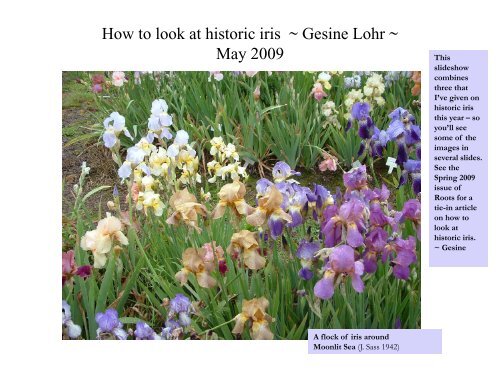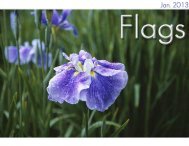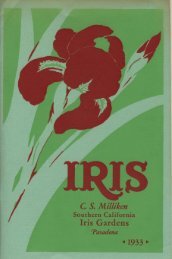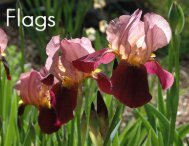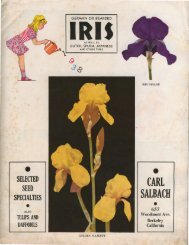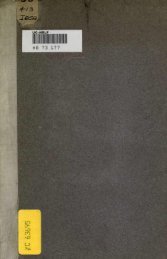How to look at historic iris ~ Gesine Lohr - Historic Iris Preservation ...
How to look at historic iris ~ Gesine Lohr - Historic Iris Preservation ...
How to look at historic iris ~ Gesine Lohr - Historic Iris Preservation ...
You also want an ePaper? Increase the reach of your titles
YUMPU automatically turns print PDFs into web optimized ePapers that Google loves.
<strong>How</strong> <strong>to</strong> <strong>look</strong> <strong>at</strong> his<strong>to</strong>ric <strong>iris</strong> ~ <strong>Gesine</strong> <strong>Lohr</strong> ~<br />
May 2009<br />
A flock of <strong>iris</strong> around<br />
Moonlit Sea (J. Sass 1942)<br />
This<br />
slideshow<br />
combines<br />
three th<strong>at</strong><br />
I’ve given on<br />
his<strong>to</strong>ric <strong>iris</strong><br />
this year – so<br />
you’ll see<br />
some of the<br />
images in<br />
several slides.<br />
See the<br />
Spring 2009<br />
issue of<br />
Roots for a<br />
tie-in article<br />
on how <strong>to</strong><br />
<strong>look</strong> <strong>at</strong><br />
his<strong>to</strong>ric <strong>iris</strong>.<br />
~ <strong>Gesine</strong>
Mussolini (Dykes K. 1932)
Start with color, but some things <strong>to</strong> <strong>look</strong> <strong>at</strong> are:<br />
Color of ~<br />
• **standards<br />
• **falls<br />
• **beard<br />
• Reticul<strong>at</strong>ions<br />
• style arms<br />
• Purple based foliage?<br />
Type of branching of<br />
flowering stalk ~<br />
Fragrance? ~<br />
Sachem<br />
(Loomis 1930)<br />
Standards & falls ~<br />
– Shape & carriage<br />
– Substance<br />
Reticul<strong>at</strong>ions ~<br />
– <strong>How</strong> far down?<br />
– thick? thin?<br />
– Changing?<br />
Beard ~<br />
– <strong>How</strong> far down?<br />
– thick? thin?<br />
– Changing?
Shape & carriage of falls and standards – Stalk vari<strong>at</strong>ions<br />
These two pages are from “Bearded <strong>Iris</strong> – A Perennial Suited <strong>to</strong> All Gardens” by Austin W. W. Sand,<br />
Cornell Extension Bulletin 112, June 1925
Things <strong>to</strong> notice!<br />
-- Carriage, shape of standards & falls<br />
-- Different types of flowering stalks – wh<strong>at</strong> is the<br />
branching?<br />
[Look <strong>at</strong> these things first, before get lost in color!]<br />
-- Get ideas from the AIS <strong>iris</strong> info card<br />
COLOR of course –<br />
color of standards, falls,<br />
color of reticul<strong>at</strong>ions,<br />
color of beard,<br />
color of style arms.<br />
Any reticul<strong>at</strong>ions? <strong>How</strong> far down the fall do they go? further than<br />
the end of beard, or where?<br />
Look <strong>at</strong> the beard --- is it bushy, thin, sparse, p<strong>at</strong>chy, wooly? <strong>How</strong> far<br />
down the fall does it go?<br />
Is the beard one color up near the start and another lower down?<br />
Do the hairs have one color <strong>at</strong> their base and another <strong>at</strong> their<br />
ends? (“yellow tip’t” is often seen in period descriptions).<br />
Remember <strong>to</strong> notice if purple based foliage or not! (pbf)<br />
Fragrance! Or not? Wh<strong>at</strong> like? Faint? strong?<br />
WHEN does she bloom? Early, mid, l<strong>at</strong>e? Any rebloom? <strong>How</strong><br />
long in bloom?<br />
Substance of flower -- thin, thick? holds up well <strong>to</strong> wind, sun, or<br />
not?<br />
<strong>How</strong> prolific, or not, is increase?<br />
<strong>How</strong> “floriferous”? how many flowers typically?<br />
And don’t forget -- WRITE DOWN your notes!
Alcazar (Vilmorin 1910)<br />
The Black Douglas (Sass J. 1934)<br />
Purple bi<strong>to</strong>nes!<br />
Left Monsignor<br />
(Vilmorin-Andrieux 1907)<br />
Rose-Marie (Cayeux 1929)
Dominion (Bliss 1917)<br />
Alcazar (Vilmorin 1910)
Souvenir de Madame Gaudichau<br />
(Millet 1914)
Ballerine (Vilmorin 1920)<br />
Monsignor (Vilmorin-Andrieux 1907)
C<strong>at</strong>erina (Foster M. 1909)<br />
Tamerlan (Vilmorin 1904)<br />
Crusader (Foster 1913)
Sir Michael (Yeld 1925)<br />
Red violet bi<strong>to</strong>nes<br />
Morning Splendor<br />
(Shull 1923)<br />
Jacquesiana (Lemon<br />
1840) & Ambassadeur<br />
(Vilmorin 1920)<br />
Voltigeur<br />
(Cayeux 1934)<br />
Persan<br />
(Cayeux 1938)
Morning Splendor (Shull 1923)
Romance (Murrell 1928)<br />
My Maryland (Sheets 1930)
K<strong>at</strong>e Izzard (Meyer 1939)<br />
Orelio (De Forest 1947)
Lantern Magique (Cayeux 1957)<br />
Tea Rose (Whiting 1942)
Rose Unique (Farr 1910)<br />
Golden Flare (Insole 1931)<br />
Flaring falls<br />
Zingara IB<br />
(Williamson<br />
1928)<br />
right<br />
Pink Jadu (Sturtevant 1931)<br />
TB M R8L A very lovely<br />
white 'Plic<strong>at</strong>a', with<br />
beautifully frilled and ruffled<br />
white standards, edged soft<br />
violet and with flaring falls<br />
of the same color and<br />
marking, with deep maroon<br />
veins <strong>at</strong> the thro<strong>at</strong> and a<br />
deep orange beard. The<br />
color on the edge of the falls<br />
is in the form of a fe<strong>at</strong>her<br />
stitching, and on the<br />
standards the color is in the<br />
form of a soft flush and<br />
peppering. Al<strong>to</strong>gether<br />
lovely. (Robert Wayman 1940)<br />
Broadway Star (Schreiner 1957)
W. R. Dykes (Dykes-Orping<strong>to</strong>n 1926) 38” M<br />
Immense yellow blooms with long broad F, sometimes<br />
dappled in red-purple splotches, orange B. (Superstition<br />
<strong>Iris</strong> Gardens)<br />
Some long hanging falls<br />
Mussolini (Dykes K. 1932)<br />
Unusual! Large flowers with<br />
elong<strong>at</strong>ed petals, lilac-lavender S,<br />
medium violet F with white<br />
veining; from England.<br />
(Superstition <strong>Iris</strong> Gardens)<br />
Broceliande (Cayeux 1935)
Jumbo Rose (Austin 1964)<br />
Broceliande (Cayeux 1935)
Byzantium (Ayres 1934)<br />
Cours-la-Reine (Cayeux 1938)
Horned Mystery<br />
(Lloyd Austin, R. 1960)<br />
Some beard vari<strong>at</strong>ions ~<br />
White Unicorn<br />
(Lloyd Austin, R. 1961)<br />
The Black Douglas<br />
(Sass J. 1934)<br />
Butterfly Wings (C. G. White, R. 1945)<br />
Red Butterfly (Linse, R. 1955) TB 40" M<br />
Reverse bicolor. S. rose-red, F. white lined<br />
dahlia-purple, dark lilac-purple <strong>at</strong> tips of<br />
F.; barium-yellow beard. Fertile both<br />
ways. Butterfly Wings X Spellbound.<br />
(Easy Breeze 1956)
Easter Bonnet (Maxwell 1943) TB, 40, M, Blend, S:<br />
pink with yellow rim, F: pink, blue blaze, yellow <strong>at</strong><br />
haft with maroon lines, edged gold, B: orange<br />
(Bluebird Haven <strong>Iris</strong> Garden)<br />
Blends<br />
Description<br />
from Cayeux<br />
et Le Clerc<br />
1930
Sindjkha (Sturtevant 1918)<br />
& Serenite (Cayeux 1931)<br />
C<strong>at</strong>erina (Foster 1909) Color effect<br />
a light lavender-violet self, veined on<br />
the outer haft. S. light lavender,<br />
veined olive on the outer haft. F.<br />
lavender-violet, widely veined olive<br />
on white outer haft. The beard is<br />
very coarse tho sparse, white, and<br />
yellow tipped. The bloom is large,<br />
delic<strong>at</strong>ely colored, and most<br />
fragrant. The variety is exceptional<br />
for its tall, many-flowered spikes and<br />
persistant winter foliage. (Cornell<br />
Bull. 112)<br />
(Cayeux et Le Clerc 1930)
Sindjkha (Sturtevant 1918)<br />
and Serenite (Cayeux 1931)
Chantilly (Hall 1943)<br />
Evolution (Cayeux 1929)
Beotie (Cayeux 1932)<br />
Nuee d’Orage (Verdier 1905)
Rose Unique (Farr 1910)<br />
Sindjkha (Sturtevant 1918)
Easter Bonnet (Maxwell 1943)
Pink Clover (Whiting R. 1953)<br />
Pink S<strong>at</strong>in (Sass J. 1930)<br />
Pink Jadu (Sturtevant 1931)
Nuee D’Orage (Verdier 1905)<br />
Andromede (Vilmorin 1926) //
Some old <strong>iris</strong> c<strong>at</strong>alog pictures are very helpful…<br />
Asia (Yeld 1920)<br />
1937 N<strong>at</strong>ional<br />
c<strong>at</strong>alog, & in our<br />
garden<br />
…and some are not!<br />
Green Chance (Murray, R. 1954)<br />
Sdlg. 139-50. TB, 40“ M<br />
Yellow-<strong>to</strong>ned bi<strong>to</strong>ne. Light<br />
chartreuse and olive green, some<br />
reticul<strong>at</strong>ions. Appointee x Green<br />
Pastures. Tell 1955
Minnesota Mixed-Up Kid (unk., ca. 1970)<br />
Chimeras!
Vingolf<br />
(Goos & Koenemann 1924)<br />
Anne Leslie<br />
(Sturtevant 1917)
Drady (unknown hybridizer before 1960)<br />
Wabash (Williamson 1936)
Maid of As<strong>to</strong>l<strong>at</strong> (Sass J. 1936)<br />
(pho<strong>to</strong> by Bonnie Petheram)<br />
Fairy (Kennicott 1905)
Plic<strong>at</strong>as, often confused but quite distinct<br />
Los Angeles (Mohr-Mitchell 1927) 46” M Snowy white S<br />
faintly edged pale lavender blue; white F beautifully<br />
reticul<strong>at</strong>ed red-brown <strong>at</strong> the base; yellow-gold B; large<br />
flowers. AM 44 (Superstition <strong>Iris</strong> Gardens 2007)<br />
San Francisco (Mohr 1927) From the 1936 Carl Salbach<br />
c<strong>at</strong>alog: Tall stems, branching low and wide like a<br />
candelabrum, carry large white flowers, of which both<br />
standards and falls are distinctly edged lavender....similar <strong>to</strong><br />
Los Angeles but with wider blue edging. Mid-season, 40-inch
Seduction (Cayeux 1933)<br />
True Charm (Sturtevant 1920)
True Delight<br />
(Sturtevant<br />
1924)<br />
Swerti (Collected in 1612) Diploid—blue and white plic<strong>at</strong>a;<br />
smaller flower. Was on the Official AIS Black List in 1925!<br />
(Superstition <strong>Iris</strong> Gardens)<br />
Plic<strong>at</strong>a, very dainty, mini<strong>at</strong>ure light lavender and white plic<strong>at</strong>a;<br />
edges of falls curl under; delightful grape fragrance. (Bluebird<br />
Haven <strong>Iris</strong> Garden)
Bertha Gersdorff (Sass J.<br />
1942)(possibly the first<br />
lumin<strong>at</strong>a)<br />
Lumin<strong>at</strong>as are usually distinctive<br />
Moonlit Sea (Sass 1942)
At Dawning (Kirkland 1935)<br />
Bertha Gersdorff (J. Sass 1942)
Moonlit Sea (J. Sass 1942)
Some <strong>iris</strong> are quite distinctive, hard <strong>to</strong> confuse with others<br />
Eldorado (Vilmorin 1910) Color effect a bronzed<br />
lilac and purple blend. S. livid purple<br />
bronzing aniline yellow. F. raisin purple<br />
bronzed, fading <strong>to</strong> light phlox purple. The<br />
beard is dense, projecting, and conspicuously<br />
orange, contrasting strongly with the showy,<br />
light violet crests. This is a distinct variety, of<br />
moder<strong>at</strong>e growth and excellent as a cut flower.<br />
R<strong>at</strong>ing 76. (Cornell Bulletin 112)<br />
Exotic and unusual diploid from France; yellowishbronze<br />
S shaded heliotrope; bright petunia<br />
purple F <strong>to</strong>uched bronze <strong>at</strong> the sides; open<br />
form! (Superstition <strong>Iris</strong> Gardens 2007 c<strong>at</strong>alog)<br />
Left ~ Magic Rosette (Austin 1966)(!)
Blue Tulip (Knocke, R. 1962) Sdlg.<br />
K-S. TB, 38" (97 cm), M Fancy,<br />
blue self with green mid-ribs;<br />
tulip-shaped, no beard or<br />
anthers. Cliffs of Dover X<br />
Harbor Blue. Tell 1964<br />
(yes, this <strong>iris</strong> is open!)<br />
Full House (D. Meek, R. 1976)<br />
Sdlg. 66-95-6. TB (novelty), 34" (86<br />
cm), M Apricot orange self; bright<br />
mandarin orange beard; five S. and F.<br />
(Flaming Heart x Mauve Magic) X<br />
self. Keppel, Melrose Gardens 1976<br />
Painted Doll<br />
(D. Boen, R. 1957)
Jumbo Rose (Austin 1964)<br />
Andromede (Vilmorin 1926) //
For excellent color pho<strong>to</strong>s of his<strong>to</strong>ric <strong>iris</strong> on the web, see<br />
The former website of HIPS, by Mike Lowe -- very beautiful pho<strong>to</strong>s!<br />
www.world<strong>iris</strong>.com/public_html/Frame_pages/QFix.html<br />
The HIPS website has a visi<strong>to</strong>r’s section, must join HIPS <strong>to</strong> see all the pho<strong>to</strong>s<br />
-- for some pho<strong>to</strong>s, see<br />
www.hips-roots.com<br />
Phil Edinger has vetted the pho<strong>to</strong>s here as correct.<br />
You can join HIPS online! or by mail.<br />
Rick Tasco and Roger Duncan (of Superstition <strong>Iris</strong> Gardens) show over 200 pho<strong>to</strong>s<br />
of his<strong>to</strong>ric <strong>iris</strong> (scroll down the page <strong>to</strong> see the his<strong>to</strong>ric <strong>iris</strong> area)<br />
http://community.webshots.com/user/rickt103<br />
Their email is randrcv@sierr<strong>at</strong>el.com if you want <strong>to</strong> order a c<strong>at</strong>alog ($1.50)<br />
Excellent place <strong>to</strong> order his<strong>to</strong>rics! and modern <strong>iris</strong> <strong>to</strong>o<br />
Another not-<strong>to</strong>o-far-<strong>to</strong>-drive place selling many his<strong>to</strong>rics is Bluebird Haven <strong>Iris</strong> Garden,<br />
(530) 620-5017 c<strong>at</strong>alog $1.00<br />
www.bluebirdhaven<strong>iris</strong>garden.com, www.bluebirdhaven<strong>iris</strong>garden.com/siteV2/c<strong>at</strong>alog.html<br />
Mary Hess’ email is mhess1863@innercite.com<br />
Excellent place <strong>to</strong> order his<strong>to</strong>rics! huge number of cultivars<br />
Also, Mary will grow your “unknown” <strong>iris</strong> for you! and try <strong>to</strong> identify them.<br />
A wonderful introduction <strong>to</strong> how <strong>to</strong> <strong>look</strong> <strong>at</strong> <strong>iris</strong>, wonderful detailed descriptions<br />
“Bearded <strong>Iris</strong> - A Perennial Suited <strong>to</strong> All Gardens”, Austin W. W. Sand,<br />
Cornell Extension Bulletin 112, June, 1925. You can order this from His<strong>to</strong>ric <strong>Iris</strong> Preserv<strong>at</strong>ion Society, $8.00 postpaid <strong>at</strong><br />
www.hips-roots.com/visi<strong>to</strong>rs/v-shoppe.html<br />
You may also order by sending a check or Money Order <strong>to</strong>:<br />
Dorothy A. Stiefel, 260 Michigan Hollow Rd., Spencer, NY 14883 e-mail: <strong>Iris</strong>Acher@aol.com<br />
Phil Edinger, HIPS’ old <strong>iris</strong> ID guru, calls this “the best old <strong>iris</strong> reference in existence”.<br />
To join HIPS (His<strong>to</strong>ric <strong>Iris</strong> Preserv<strong>at</strong>ion Society)<br />
Via internet, you can join <strong>at</strong> www.hips-roots.com/visi<strong>to</strong>rs/v-membership.html<br />
Or, mail dues (single annual 10.00, single triennial 24.00, dual annual 12.00, dual triennial 30.00) <strong>to</strong><br />
Membership Secretary, Judy Eckhoff, 7911 S. Yoder Rd, Haven, KS 67543-8114<br />
Roots, the journal of HIPS, comes out twice a year. There is a HIPS Rhizome Sale yearly.<br />
Please feel free <strong>to</strong> email or<br />
write <strong>to</strong> me,<br />
<strong>Gesine</strong> <strong>Lohr</strong><br />
Let me know if you’d like a list<br />
of the <strong>iris</strong> shown <strong>to</strong>day (via<br />
regular mail, or email).<br />
I would be glad <strong>to</strong> email you<br />
some pho<strong>to</strong>s of his<strong>to</strong>ric <strong>iris</strong>. I<br />
archive old <strong>iris</strong> c<strong>at</strong>alogs (they<br />
are treasures!) and have<br />
scanned some of them, can send<br />
on a CD.<br />
gesine.lohr@gmail.com<br />
<strong>Gesine</strong> <strong>Lohr</strong>, 1226 High Street<br />
Alameda, CA 94501<br />
(510) 864-7962


